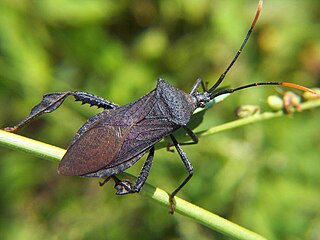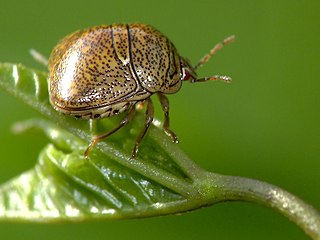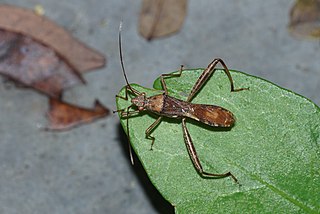
The Pentatomoidea are a superfamily of insects in the Heteroptera suborder of the Hemiptera order. As Hemiptera, they share a common arrangement of sucking mouthparts. The roughly 7000 species under Pentatomoidea are divided into 21 families. Among these are the shield bugs, giant shield bugs, burrower bugs, and stink bugs.

Ranatra is a genus of slender predatory insects of the family Nepidae, known as water scorpions or water stick-insects. There are around 100 Ranatra species found in freshwater habitats around the world, both in warm and temperate regions, with the highest diversity in South America and Asia. Fewer are found elsewhere, but include several African, some in North America, three from Australia and three from the Palearctic, notably the relatively well-known European R. linearis.

Naucoridae is a small family of insects commonly known as the creeping water bugs and saucer bugs. They are similar in appearance and behavior to Belostomatidae, but considerably smaller, at 0.5–2 cm (0.2–0.8 in) long. Naucoridae are found around the world, but the greatest diversity is in tropical regions. They inhabit a wide range of freshwater habitats, ranging from still waters like ponds, to flowing rivers and even torrential streams. There are about 400 species in 40 genera in 5 subfamilies.

Sinea is a New World genus of assassin bugs, in the subfamily Harpactorinae. 13 species have been described, mostly from the Southwestern United States and Central America.

Acanthocephala is a New World genus of true bugs in the family Coreidae. The name is derived from the Greek akanth- meaning "thorn/spine" + kephale meaning "head" This name is in reference to the spine on the front of the head.

Megacopta cribraria, also called the bean plataspid, kudzu bug, globular stink bug and lablab bug, is a shield bug native to India and China, where it is an agricultural pest of lablab beans and other legumes. The bug, while harmless to houseplants and people, often enters houses. It is attracted to white surfaces such as the walls of houses or white vehicles, because of the high reflectance of the white surfaces as it relates to the bugs' simple eyes. As a defense mechanism, they emit a foul-smelling pheromone that also acts as a congregation pheromone. Aside from smelling foul, the liquid also creates a burning sensation and sometimes leaves a red welt on bare skin. It is similar to other Plataspidae in having a somewhat unusual symbiotic relationship with its gut bacteria. Before laying eggs, females deposit particles containing the symbiont, which are then eaten by newly hatched nymphs under natural conditions. Nymphs experimentally deprived of access to the symbiont exhibited slower growth, smaller body sizes and higher mortality.

Cosmopepla is a genus of stink bugs in the family Pentatomidae. Cosmopepla lintneriana is the type species. Cosmopepla lintneriana was first described in 1798 by Johan Christian Fabricius as Cimex carnifex.

Blissus is a genus in the true bug family Blissidae, commonly called chinch bugs in North America. The review by Slater (1979) listed 27 species. The species B. leucopterus, B. occiduus and B. insularis are important pests of cereal crops and turf grasses in their different ranges in the United States.

Graptostethus is a genus in the insect family Lygaeidae. Although originally restricted to the Old World some species like G. servus have spread to parts of the New World.

Brachyplatys is a genus of shield bugs belonging to the family Plataspidae.

Nerthra is a genus of toad bugs in the family Gelastocoridae. There are at least 90 described species in Nerthra.

Kalama is a genus of lace bugs in the family Tingidae. There are at least 30 described species in Kalama.

Dictyla is a genus of lace bugs in the family Tingidae. There are at least 80 described species in Dictyla.
Limnocoris is a genus of creeping water bugs in the family Naucoridae. There are more than 70 described species in Limnocoris.

Pelocoris is a genus of creeping water bugs in the family Naucoridae. There are about 15 described species in Pelocoris.
Dendrocoris is a genus of stink bugs in the family Pentatomidae. There are about 11 described species in Dendrocoris.

Gelastocoris is a genus of toad bugs in the family Gelastocoridae. There are more than 20 described species in Gelastocoris.

Dictyonota is a genus of lace bugs in the family Tingidae. There are more than 60 described species in Dictyonota.

Riptortus is a genus of broad-headed bugs in the family Alydidae. There are more than 20 described species in Riptortus.
Brachyplatys subaeneus, also referred to as the black bean bug, is a species of shield bugs belonging to the family Plataspidae, occurring throughout much of Asia, and invasive elsewhere. It is known to be a pest, particularly in legume crops, but infests a wide range of plant species.


















